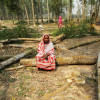Bringing the forests back to life

Over-exploitation and mismanagement of Asia-Pacific's forests have left nearly 400 million hectares of land cleared of trees or heavily degraded, according to a new report by the Food and Agriculture Organization of the United Nations (FAO). To put this into perspective, that's a total land area nearly as big as the entire Indian Subcontinent. Southeast Asia alone has more than 65 million hectares of degraded lands in need of restoration.
The Asia-Pacific region has paid a heavy price for the destruction and damage inflicted on its forests. Not only has their productive potential been lost, but stripping the protective functions of forests hasled to massive soil erosion, deadly landslides, siltation of reservoirs and depletion of biodiversity. Reckless clearing and burning of trees has resulted in choking haze and release of huge quantities of greenhouse gases into the atmosphere.
There are countless reasons why a reversal of these patterns should be a high priority. But can countries afford the intimidating price tag for restoring the region's degraded forest lands?
Using a typical expenditure of US$1,000 per hectare, for reforesting regional land with conventional approaches, it's easy to see a rapidly escalating bill upwards of US$400 billion.
But the challenges may not be as insurmountable as many have thought. The reasons for optimism centre on the convergence of a number of positive factors.
We are witnessing a new era when awareness and appreciation of the benefits gained from healthy forests has never been greater, such as the unique ability of trees to soak up carbon dioxide. The Paris climate change agreement, concluded under the United Nations Framework Convention on Climate Change in late 2015, included national commitments by many countries in the Asia-Pacific region to expand forest cover and manage existing forests better.
The universal pledge to combat climate change in Paris is generating unprecedented levels of funding for forestry from governments, donor organisations, bilateral aid agencies, development banks and investment from the private sector. There are also encouraging prospects for substantial increases in funding under the Green Climate Fund and the Global Environment Facility.
Real action in restoring forests, of course, has to take place in countries and on the ground at local levels. National financing and commitment are therefore critically important for success.
Here too, there are very promising opportunities. Economic growth has meant many countries of this region have substantial capacity to direct public expenditures for forest restoration should it be made a national priority. And some have been demonstrating that commitment for years.
The Republic of Korea has already demonstrated the potential for massive forest restoration, increasing the density of once-decimated forests more than 12-fold between 1960 and 2010, largely using its own budgetary funds.
China has boosted forest cover by more than 31 million hectares between 2000 and 2015.
The Philippines is on track to plant 1.5 billion trees over a five-year programme, increasing forest cover by more than a quarter of a million hectares per year. The country's National Greening Programme benefits from strong political and public support, backed by funds from the country's own treasury.
Simply by clarifying tenure over forest lands, cutting red tape that previously constrained the harvesting and transport of timber grown by farmers, and providing access to credit, Vietnam spurred a wave of tree planting that increased forest cover from 38 percent to 48 percent of total land in just 15 years. Clearly, when people gain tangible benefits from trees and forests, they eagerly plant, grow and protect them.
Foresters are also becoming smarter in their approaches. Experience in the Philippines and elsewhere with "assisted natural regeneration," relying on protecting the growth of naturally occurring seedlings, has cut the costs of reforestation by half in many areas, while resulting in biologically rich forest stands of native tree species well adapted to local growing conditions.
Back in 2007, twenty one APEC economies set a target of increasing forest cover in Asia-Pacific by 20 million hectares by 2020. In 2015, FAO conducted a progress review and concluded that the target would almost surely be met.
This week, more than 1,000 forestry and natural resources officials and practitioners are meeting in the Philippines, participating in the third Asia-Pacific Forestry Week where a focused consultation of the highest forestry officials and international partners are considering strategies and options for an action plan to accelerate the region's forest restoration.
With all the positive forces aligning in support of forest restoration, now is the time for Asia-Pacific countries to set a far more ambitious target for forest recovery. A target of at least 100 million hectares of restoring degraded lands by 2030 is fully achievable with strong and sustained commitment, political will, judicious funding and smart technologies.
The region's degraded lands can be restored to healthy ecosystems. Now is the time to get on with it. It's now time to truly see the forests for the trees!
The writer is senior forestry officer with the FAO Regional Office for Asia and the Pacific, Bangkok, Thailand.

 For all latest news, follow The Daily Star's Google News channel.
For all latest news, follow The Daily Star's Google News channel. 







Comments